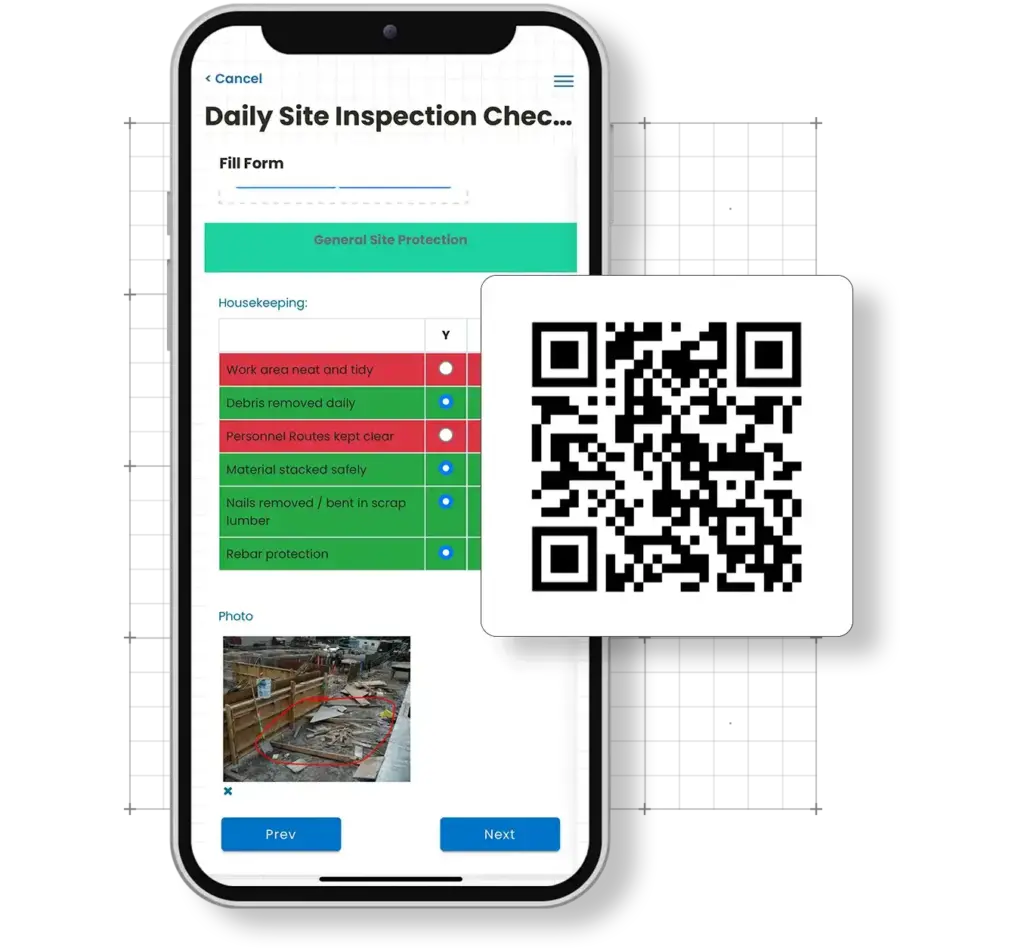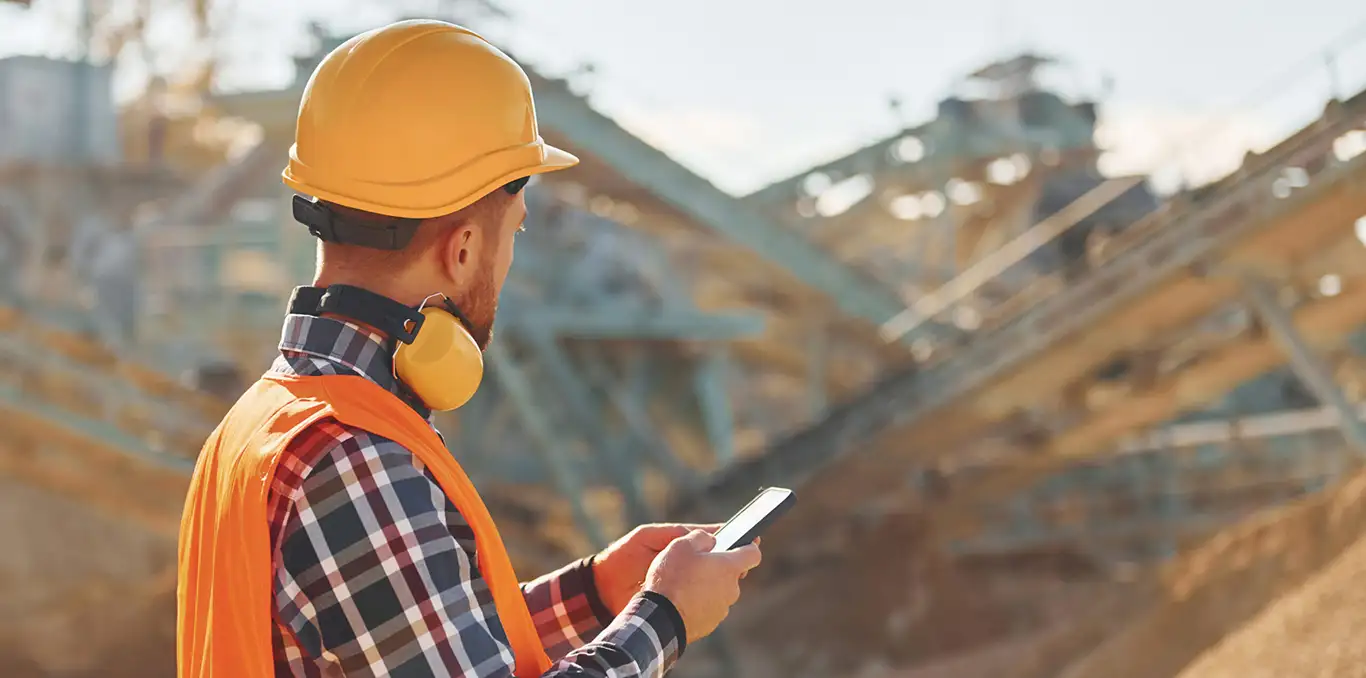You’ve seen them everywhere. Stuck on restaurant tables instead of a menu, taking the place of a concert ticket, even tattooed on the human body to Rickroll the unsuspecting. Quick Response (QR) codes are here to stay – after all, what’s more permanent than a tattoo?
QR codes are an innovative way to connect people to the information they need, which makes them perfect for a lot construction industry use cases. Here are four ways construction companies can use QR codes: equipment and tool management, safety inspections, project management, and marketing communications. Let’s take a closer look at each one…
 1. Equipment and Tool Management
1. Equipment and Tool Management
Construction companies can attach QR codes to equipment and tools to track their usage, maintenance schedules, and location. This helps to prevent loss or theft, optimize usage, and ensure that equipment is well-maintained.
- Tracking equipment location: By attaching a QR code to each piece of equipment, construction companies can use mobile devices to scan the code and determine the equipment’s exact location on the construction site. This helps to prevent equipment from getting lost or misplaced.
- Monitoring equipment usage: QR codes can also be used to monitor equipment usage, including who is using the equipment, how long they are using it for, and when it was last used. This information can help construction companies detect and prevent theft or unauthorized use of equipment.
- Tracking Maintenance Schedules: QR codes can be used to track equipment maintenance schedules, ensuring that equipment is serviced and repaired on time. This helps to prevent breakdowns and other issues that could lead to equipment damage or safety hazards.
- Identifying stolen equipment: In the unfortunate event that equipment is stolen from a construction site, QR codes can help to identify stolen equipment by enabling authorities to scan the code and trace the equipment’s ownership.
QR codes can provide construction companies with an efficient and effective way to track equipment, monitor usage, and prevent theft, helping to keep equipment safe and secure on a construction site
2. Safety Inspections
QR codes can be used to manage safety inspections on construction sites. Workers can scan the code to access safety information and checklists for specific tasks and equipment, helping to reduce accidents and injuries.
Helpful tips to use QR codes for construction safety inspections:
- Identify the specific safety inspection tasks and equipment that require QR codes. For example, you may want to use QR codes for scaffolding inspections or crane safety checks.
- Create a digital safety inspection checklist for each task or equipment. The checklist should include all the necessary safety procedures and guidelines.
- Generate a unique QR code for each task or equipment using a QR code generator tool. You can include the URL of the digital checklist in the QR code.
- Print the QR code and attach it to the task or equipment. You may want to laminate the QR code to protect it from damage.
- Train workers on how to scan the QR code using their mobile devices. Workers can use their smartphones to scan the QR code and access the digital checklist.
- Perform the safety inspection task or equipment check, and complete the digital checklist. Workers can use their mobile devices to check off each item on the checklist and provide any necessary comments.
- Submit the completed digital checklist to the appropriate supervisor or safety manager for review.
By using QR codes for construction safety inspections, workers can quickly and easily access safety information and checklists for specific tasks and equipment, helping to reduce accidents and injuries on construction sites.
3. Project Management
QR codes can be used to track progress on construction projects, enabling workers to quickly and easily record completed tasks and report any issues or delays. This helps to keep the project on schedule and within budget.
A few concrete (pun intended) examples of how to use QR codes in construction project management:
- Project tracking: Construction companies can use QR codes to track the progress of a project by assigning unique codes to specific sections or milestones of the project. This can help project managers to quickly identify where the project is at and what tasks are completed.
- Daily reporting: Workers can use QR codes to report daily progress on construction projects. By scanning the code, they can easily access a digital form to fill out with details on completed tasks, any issues or delays, and other important information.
- Document management: QR codes can be used to manage project-related documents, such as blueprints, permits, and change orders. By attaching QR codes to each document, construction workers can quickly access them from their mobile devices without having to search through physical folders.
- Time tracking: QR codes can also be used to track worker time on a construction project. By scanning the code at the beginning and end of each shift, workers can log their hours and the work they’ve completed.
- Quality control: QR codes can be used for quality control purposes, such as inspecting completed work or verifying the installation of specific components. By scanning the QR code, workers can access detailed information about the quality standards and specifications for the task at hand.
QR codes can be a powerful tool for construction companies to streamline project management, increase efficiency, and reduce errors and delays.
4. Marketing and Communication
Construction companies can use QR codes on marketing materials and signage to provide additional information about their services and projects. For example, a QR code on a billboard or brochure could lead to a video tour of a completed construction project or provide contact information for the company.
Overall, QR codes can help construction companies streamline their operations, improve safety, and provide better communication with their clients and stakeholders.
Corfix recognizes the usefulness and prevalence of QR codes in construction and our software enables you to use that technology to access forms, complete checklists, and manage workers.
